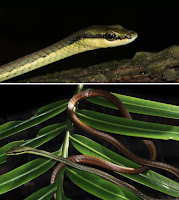 |
| Dendrelaphis wickrorum Danushka, Kanishka, Amarasinghe, Vogel & Seneviratne, 2020 |
Examination of the Dendrelaphis bifrenalis populations on Sri Lanka showed that there are two populations that are morphologically different from each other. One population is distributed only in the wet zone forests (hereafter treated as wet zone population), while the other population occurs widely in the dry zone and intermediate zones (hereafter dry zone population). The type series of D. bifrenalis consist of 3 specimens from which the specimen representing the dry zone population was chosen as lectotype, and the wet zone population is described here as a new species. It clearly differs from D. bifrenalis by having a shorter snout, orbit diameter 103-114% of eye-nostril length (vs 77-95%), and larger eye, orbit diameter 21-23% of head length (vs 17-20%). Furthermore it differs by having a temporal stripe stopping just beyond the neck (vs continues behind neck), the absence of black transverse dorsolateral bars on the anterior 1/4 th of body (vs prominent), a narrow and pointed snout (vs broad and flat), a divided nasal (vs single), and a ventrolateral stripe continuing up to the tail (vs stopping at the level of the anal plate). This morphological differentiation is supported by the divergence in the mitochondrial NADH dehydrogenase subunit 4 (ND4) region separating clearly with the divergence of 1.70±0.35%. Also, here we resurrect D. effrenis (Werner, 1909) as a valid species, and D. sinharajensis as a junior synonym of it. The holotype of D. sinharajensis was chosen as the neotype of D. effrenis to stabilize nomenclature, and to make it an objective synonym. The third and fourth known specimens of this rare species are reported. A key of the species of the genus Dendrelaphis in Sri Lanka is provided.
Key words: Holotype, island biogeography, lectotype, neotype, syntype, systematic, taxonomy.
Dendrelaphis wickrorum sp. nov.
Diagnosis. The following combination of characters distinguishes the new species from Dendrelaphis bifrenalis: shorter snout: ED 103–114% of EN (vs 77–95%), larger eye: ED 21–23% of HL (vs 17–20%), presence of a temporal stripe stopping just beyond the neck (vs continues behind neck), absence of black transverse dorsolateral bars on the anterior 1/4th of body (vs prominent), presence of a ventro-lateral stripe continuing up to the tail (vs stopping at the level of anal plate) and narrowand pointed snout (vs broad and flat). Furthermore a divided nasal (vs single) distinguishes the new species; the differences are shown in Figs. 8 & 9, and summarized inTables 6 & 7.
Etymology. The specific epithet is a noun in the genitive case, honoring Mr. L.J. Mendis Wickramasinghe and his wife Mrs. Nethu Wickramasinghe for their remarkable contributions to the field of herpetology in Sri Lanka. Especially, Mendis Wickramasinghe’s enormous effort in popularizing snake conservation among the general public is highly commendable. We shorten their modern name to the stem “Wickr” and formed in case of plura ladding the suffix [-orum].
Suggested vernacular names are වික්රමසිංහලාගේ හාල්දණ්ඩා and Wickramasinghes’ Bronze-back in Sinhala and English respectively.
A. Dineth Danushka, A. Suneth Kanishka, A. A. Thasun Amarasinghe, Gernot Vogel and Sampath S. Seneviratne. 2020. A New Species of Dendrelaphis Boulenger, 1890 (Reptilia: Colubridae) from the Wet Zone of Sri Lanka with A Redescription of Dendrelaphis bifrenalis (Boulenger, 1890). TAPROBANICA. 9(1); 83-102.


